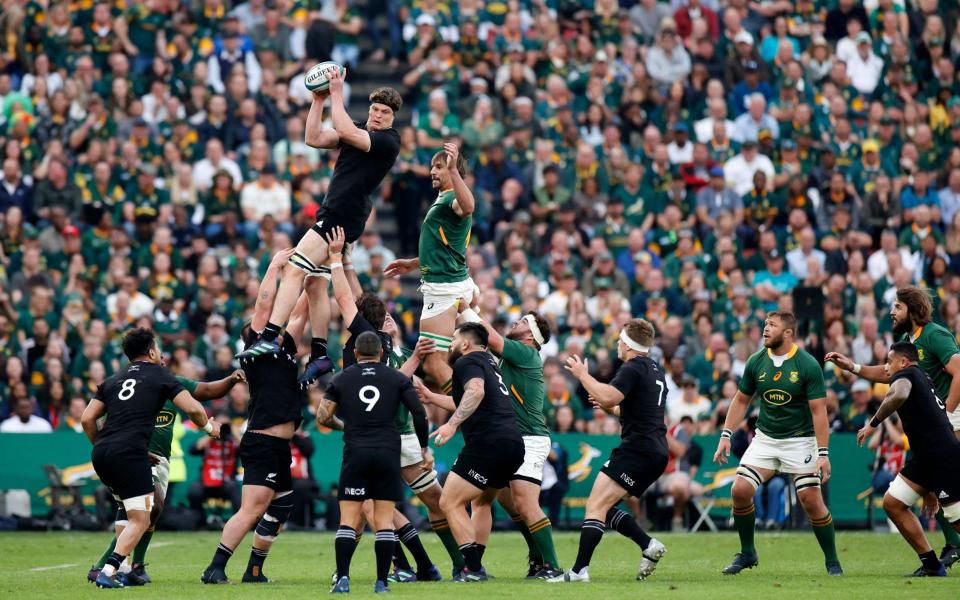What New Zealand changed to pull off an unthinkable victory over South Africa

After their struggles over the last few months, it turns out the demise of the All Blacks has been greatly exaggerated. New Zealand halted a miserable run of three straight defeats with a stunning 35-23 victory over the world champion Springboks at Ellis Park.
Whether this famous victory will result in a stay of execution for under-fire head coach Ian Foster remains unclear but what we do know is the All Blacks have found a way to win big games again. Following their Irish debacle Foster saved his own neck by dispensing with the services of forwards coach John Plumtree, and attack coach Brad Mooar.
Foster will happily take the credit for this remarkable result after copping so much flak but don’t underestimate the impact of new forwards guru Jason Ryan.
This is how New Zealand put an end to their losing run.
Maul defence
When Jason Ryan was parachuted in to the All Blacks set-up three weeks ago, he was given the very simple mandate of toughening up the pack. Ryan had identified New Zealand’s maul defence as a major weakness claiming their pack “has been dented” far too often. Foster has clearly appointed the right man to fix this area because during his time as Scott Robertson’s assistant at the Crusaders they remarkably didn’t concede a maul try for five years.
Despite losing 26-10 in the first Test New Zealand’s maul defence was significantly better than it had been in the Ireland series, but it reached perfection at Ellis Park, and was the difference between winning and losing this Test match.
South Africa have the best driving lineout in world rugby by a country mile, and it got them out of jail in their recent 2-1 Test series victory over Wales. New Zealand started well in Johannesburg but when South Africa overturned the initial 15-point deficit they turned to their most potent attacking weapon. Time and time again they got set deep in New Zealand’s 22 and attempted to shove their visitors back over their own try line.

Usually this is the period in games where sides fall apart against this gigantic South African pack, but they failed to find a way to go forward with their attacking maul. New Zealand never allowed them to gain any momentum in this area, and subsequently survived the physical onslaught the Springboks subject on most sides. Sam Whitelock also picked off numerous Springbok lineouts while South Africa head coach Jacques Nienaber got his selection at hooker wrong with Joseph Dweba’s throwing in off target.
Scrum improvement
The set-piece was another area which dramatically improved from the first Test, and this has also got Ryan’s fingerprints all over it. They were annihilated at scrum time in the first Test with both Trevor Nyakane and Frans Malherbe giving George Bower and Angus Ta’vao a torrid time. Nienaber helped the All Blacks out in this area by not selected Marx who is widely considered the best scrummaging hooker in the world, while Bongi Mbonambi’s absence was also keenly felt.
Foster’s decision to hand the relatively inexperienced props Ethan de Groot and Tyrel Lomax starts proved to be a masterstroke. From the very first scrum the All Blacks were rock solid - not giving an inch. Both de Groot and Lomax had really good shape in the scrums and made it very difficult for the South Africa's props to shove them backwards. In a similar fashion to the driving lineout the scrum was an area where the Springboks assumed they’d gain dominance, but it failed to materialise. They did win a couple of scrum penalties later in the game when de Groot and Lomax had made way for Bower and debutant Fletcher Newell but for the majority of this Test match the scrum was an even contest.
Having a solid platform at scrum time allowed the All Blacks' attack to launch set plays on the front foot, while it made it far more difficult for the Springboks to gain field position. The selection of Chiefs hooker Samisoni Taukei’aho has also been a big plus for the All Blacks. They must now continue with this front-row in the lead up to next year’s Rugby World Cup.

World class Richie Mo'unga
The omission of Richie Mo’unga for the Ireland series, and the first South African Test would have baffled those who follow both Super Rugby and the All Blacks on a consistent basis. Up to this point, Foster had kept faith with the mercurial Beauden Barrett. There is no doubt whatsoever surrounding Barrett’s ability as a rugby player, but Mo’unga is the better outside-half. The Crusaders playmaker is himself a mercurial talent and is in many ways a carefree spirit but he has a better balance in his game, and can also be pragmatic when needed.
He made one early error which nearly proved costly when his pass was intercepted by Pieter-Steph du Toit but apart from that one moment he was almost flawless. His goal kicking was world class while his tactical kicking was on point. Mo’unga has a lot of peripheral vision and can see things before other players. On one occasion New Zealand were under severe pressure in the South Africa 22, but instead of taking the easy option which would have been kicking to touch Mo’unga threw a wide pass which sparked an All Blacks attack.
The variety of his passing was the key to unlocking a suffocating Springboks rush defence. His subtle inside passes played havoc with South Africa and on one such occasion he sent David Havili racing 60 metres downfield. The range of his passing ran the South Africans off their feet, and it is no surprise to see Rieko Ioane have his best game for a long time with Mo’unga at ten.
He’s an outrageous talent who can make impossible things happen but it’s his decision making, game management, and the balance in his game with regards to when to attack and when to be cautious which has propelled him into the world-class bracket.

Strong aerial game
In Test one this was another area South Africa won hands down. New Zealand were a mess under the high ball, and South Africa fed off this. But in Johannesburg, the All Blacks gave nothing away in the air, and as a result they succeeded in turning South Africa’s kicking game into a weakness.
It was obvious the Springboks thought the New Zealand back three would be suspect under the high ball. In both Tests, the world champions employed the rather unusual tactic of the number nine opting for a long up and under when deep inside New Zealand's half. This worked a treat last weekend, but it backfired this time around. Will Jordan was superb under the high ball as was Jordie Barrett, and the All Blacks didn’t just deal with the up and under they were able to turn it into attacking opportunities. What summed up the Springboks the most was just after the hour mark they were camped deep in New Zealand’s half in a relatively promising attacking position.
Instead of going through the phases and trying to work an overlap scrum-half Jaden Hendrikse launched a speculative up and under which New Zealand took with ease. The Springboks had run out of ideas and were outthought over the course of the 80 minutes.
Winning the breakdown
For the best part of 15 years, New Zealand were unrivalled at the breakdown and are responsible for giving this aspect of the game the attention it now receives. It helped their cause to have the best openside, if not player, of the professional era in the shape of Richie McCaw in their ranks.
But over the past few months they have really struggled in this area. Current openside, and team captain, Sam Cane has been the target of fierce criticism, but this is unfair. Ireland’s Tadhg Beirne took them apart in July, while Malcolm Marx did a serious job in this area last weekend. Whereas in the past winning turnovers might have been the job of one player it is now far more of a collective effort which is why it was ludicrous to pin all the blame on Cane.
New Zealand were unable to slow South Africa’s attacking ball down in the first Test, but the selection of the physical Shannon Frizell aided Cane’s efforts at the breakdown. Cane was very effective at slowing the Springboks down in this area, and the Chiefs man is a player who does the unseen dirty work which rarely results in plaudits. There were a number of occasions where the Springboks got ahead of steam in the All Blacks 22 but were picked off at the breakdown by Cane and Ardie Savea.
Even though South Africa possessed the stronger pack New Zealand were not overpowered and were far more aggressive in the contact. The physicality in defence from the likes of Taukei’aho, Frizell, Scott Barrett, and David Havili gave their fetchers a better chance to win turnover ball.

 Yahoo Sport
Yahoo Sport 





































